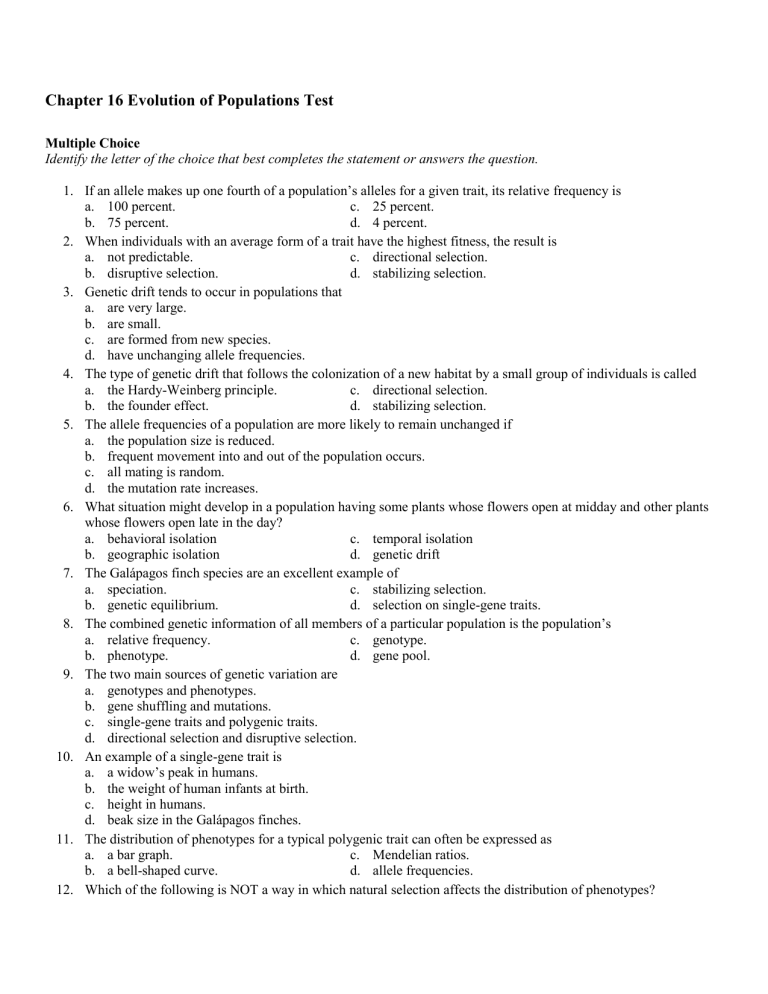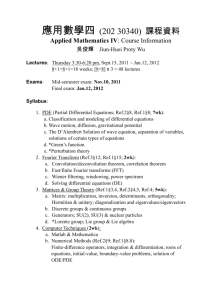Chapter 16 Evolution of Population Test

Chapter 16 Evolution of Populations Test
Multiple Choice
Identify the letter of the choice that best completes the statement or answers the question.
1. If an allele makes up one fourth of a population’s alleles for a given trait, its relative frequency is a. 100 percent. b. 75 percent. c. 25 percent. d. 4 percent.
2. When individuals with an average form of a trait have the highest fitness, the result is a. not predictable. c. directional selection. b. disruptive selection. d. stabilizing selection.
3. Genetic drift tends to occur in populations that a. are very large. b. are small. c. are formed from new species. d. have unchanging allele frequencies.
4. The type of genetic drift that follows the colonization of a new habitat by a small group of individuals is called a. the Hardy-Weinberg principle. b. the founder effect. c. directional selection. d. stabilizing selection.
5. The allele frequencies of a population are more likely to remain unchanged if a. the population size is reduced. b. frequent movement into and out of the population occurs. c. all mating is random. d. the mutation rate increases.
6. What situation might develop in a population having some plants whose flowers open at midday and other plants whose flowers open late in the day? a. behavioral isolation b. geographic isolation c. temporal isolation d. genetic drift
7. The Galápagos finch species are an excellent example of a. speciation. c. stabilizing selection. b. genetic equilibrium. d. selection on single-gene traits.
8. The combined genetic information of all members of a particular population is the population’s a. relative frequency. c. genotype. b. phenotype. d. gene pool.
9. The two main sources of genetic variation are a. genotypes and phenotypes. b. gene shuffling and mutations. c. single-gene traits and polygenic traits. d. directional selection and disruptive selection.
10. An example of a single-gene trait is a. a widow’s peak in humans. b. the weight of human infants at birth. c. height in humans. d. beak size in the Galápagos finches.
11. The distribution of phenotypes for a typical polygenic trait can often be expressed as a. a bar graph. c. Mendelian ratios. b. a bell-shaped curve. d. allele frequencies.
12. Which of the following is NOT a way in which natural selection affects the distribution of phenotypes?
a. directional selection b. stabilizing selection c. disruptive selection d. chance events
13. In genetic drift, allele frequencies change because of a. mutations. c. natural selection. b. chance. d. genetic equilibrium.
14. Which of the following events do biologists consider a random change? a. directional selection c. disruptive selection b. speciation d. genetic drift
15. The situation in which allele frequencies of a population remain constant is called a. evolution. c. genetic equilibrium. b. genetic drift. d. natural selection.
16. Which is the first step that occurred in the speciation of the Galápagos finches? a. establishment of genetic equilibrium c. ecological competition b. behavioral isolation d. arrival of the founding population
Chapter 16 Evolution of Populations Test
Answer Section
MULTIPLE CHOICE
1. REF: p. 394
2. REF: p. 399
3. REF: p. 400
4. REF: p. 400
5. REF: p. 401
6. REF: p. 405
7. REF: p. 408
8. REF: p. 394
9. REF: p. 394
10. REF: p. 395
11. REF: p. 396
12. REF: p. 398
13. REF: p. 400
14. REF: p. 400
15. REF: p. 401
16. REF: p. 408



